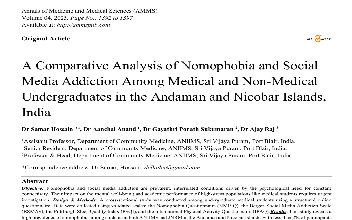A Comparative Analysis of Nomophobia and Social Media Addiction Among Medical and Non-Medical Undergraduates in the Andaman and Nicobar Islands, India
Authors
##plugins.themes.bootstrap3.article.main##
Abstract
Objective: Nomophobia and social media addiction are prevalent, interrelated conditions driven by the psychological need for constant connectivity. Their impact on the mental well-being and academic performance of high-stress populations like medical students requires urgent investigation. Design & Methods: A cross-sectional study was conducted among undergraduate medical students using a structured online questionnaire. Data were collected using validated scales: the Nomophobia Questionnaire (NMP-Q), the Bergen Social Media Addiction Scale (BSMAS), the Pittsburgh Sleep Quality Index (PSQI), and the International Physical Activity Questionnaire (IPAQ).Results: This study reveals a high prevalence of nomophobia among students at both ANIIMS and JNRM in the Andaman and Nicobar Islands, with less than 2% of participants reporting no symptoms. JNRM students exhibited a broader spread across severity levels, including higher proportions of severe nomophobia, whereas ANIIMS students were predominantly in the moderate category. Conclusions: In conclusion, this study confirms the high prevalence of nomophobia among students in the Andaman and Nicobar Islands, while revealing key inter-institutional differences. The JNRM cohort, characterized by heavier usage, showed a greater tendency toward severe nomophobia and poorer sleep quality compared to ANIIMS.
##plugins.themes.bootstrap3.article.details##
Copyright (c) 2025 Dr Samar Hossain, Dr Aanchal Anand, Dr Gayathri Ponath Sukumaran, Dr Ajay Raj

This work is licensed under a Creative Commons Attribution 4.0 International License.
Creative Commons License All articles published in Annals of Medicine and Medical Sciences are licensed under a Creative Commons Attribution 4.0 International License.
Dr Samar Hossain, Assistant Professor, Department of Community Medicine, ANIIMS, Sri Vijaya Puram, Port Blair, India.
Assistant Professor, Department of Community Medicine, ANIIMS, Sri Vijaya Puram, Port Blair, India.
Dr Aanchal Anand, Assistant Professor, Department of Community Medicine, ANIIMS, Sri Vijaya Puram, Port Blair, India.
Assistant Professor, Department of Community Medicine, ANIIMS, Sri Vijaya Puram, Port Blair, India.
Dr Gayathri Ponath Sukumaran, Senior Resident, Department of Community Medicine, ANIIMS, Sri Vijaya Puram, Port Blair, India.
Senior Resident, Department of Community Medicine, ANIIMS, Sri Vijaya Puram, Port Blair, India.
Dr Ajay Raj, Professor & Head, Department of Community Medicine, ANIIMS, Sri Vijaya Puram, Port Blair, India.
Professor & Head, Department of Community Medicine, ANIIMS, Sri Vijaya Puram, Port Blair, India.
[1] Williams A. Twenge, J. M. (2017). iGen: Why Today’s Super-Connected Kids Are Growing Up Less Rebellious, More Tolerant, Less Happy and Completely Unprepared for Adulthood. New York, NY: Atria. ISBN: 978-1-5011-5201-6 paperback. 342 pp. Family and Consumer Sciences Research Journal. 2020;48(3):290–3.
[2] Cheever NA, Rosen LD, Carrier LM, Chavez A. Out of sight is not out of mind: The impact of restricting wireless mobile device use on anxiety levels among low, moderate and high users. Computers in Human Behavior. 2014 Aug 1;37:290–7.
[3] Bhattacharya S, Bashar MA, Srivastava A, Singh A. NOMOPHOBIA: NO MObile PHone PhoBIA. J Family Med Prim Care. 2019 Apr;8(4):1297–300.
[4] Clayton RB, Leshner G, Almond A. The Extended iSelf: The Impact of iPhone Separation on Cognition, Emotion, and Physiology. JCMC. 2015 Aug;20(2):119–35.
[5] Diagnostic and statistical manual of mental disorders: DSM-5TM, 5th ed. Arlington, VA, US: American Psychiatric Publishing, Inc.; 2013. xliv, 947 p. (Diagnostic and statistical manual of mental disorders: DSM-5TM, 5th ed).
[6] Griffiths M. A ‘components’ model of addiction within a biopsychosocial framework. Journal of Substance Use. 2005 Jan 1;10(4):191–7.
[7] Kuss DJ, Griffiths MD. Online Social Networking and Addiction-A Review of the Psychological Literature. Int J Environ Res Public Health. 2011 Sept;8(9):3528–52.
[8] Schou Andreassen C, Billieux J, Griffiths MD, Kuss DJ, Demetrovics Z, Mazzoni E, et al. The relationship between addictive use of social media and video games and symptoms of psychiatric disorders: A large-scale cross-sectional study. Psychol Addict Behav. 2016 Mar;30(2):252–62.
[9] Przybylski AK, Murayama K, DeHaan CR, Gladwell V. Motivational, emotional, and behavioral correlates of fear of missing out. Computers in Human Behavior. 2013 July 1;29(4):1841–8.
[10] International Telecommunication Union (ITU). Measuring digital development: Facts and figures 2023 [Internet]. Geneva: ITU; 2023. Available from: https://www.itu.int/itu-d/reports/statistics/facts-figures-2023/
[11] Guidelines on physical activity, sedentary behaviour and sleep for children under 5 years of age [Internet]. [cited 2025 Oct 8]. Available from: https://www.who.int/publications/i/item/9789241550536
[12] Exelmans L, Van den Bulck J. Bedtime mobile phone use and sleep in adults. Soc Sci Med. 2016 Jan;148:93–101.
[13] Chang AM, Aeschbach D, Duffy JF, Czeisler CA. Evening use of light-emitting eReaders negatively affects sleep, circadian timing, and next-morning alertness. Proc Natl Acad Sci U S A. 2015 Jan 27;112(4):1232–7.
[14] Alvaro PK, Roberts RM, Harris JK. A Systematic Review Assessing Bidirectionality between Sleep Disturbances, Anxiety, and Depression. Sleep. 2013 July 1;36(7):1059–68.

